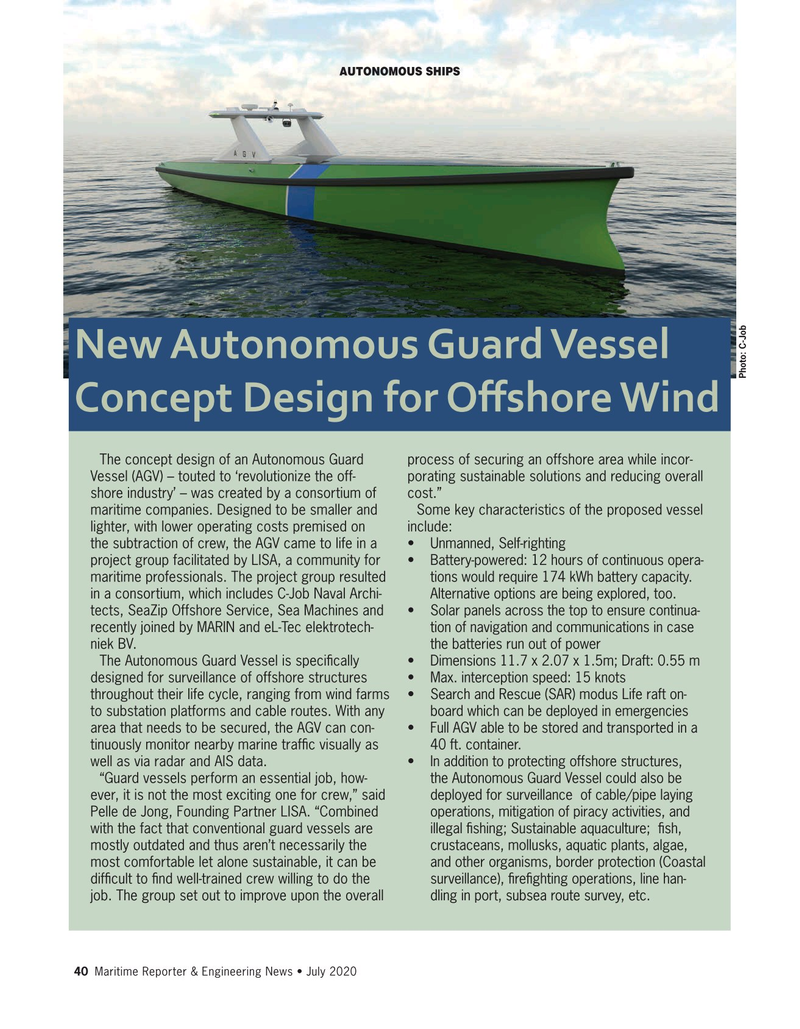
Page 40: of Maritime Reporter Magazine (July 2020)
Maritime Power Edition
Read this page in Pdf, Flash or Html5 edition of July 2020 Maritime Reporter Magazine
auTonoMous sHips
THE MARITIME
INDUSTRY’S GLOBAL
New Autonomous guard vessel
INFORMATION
Photo: C-Job
Concept Design for Ofshore Wind
GATEWAY
The concept design of an Autonomous Guard process of securing an offshore area while incor-
Vessel (AGV) – touted to ‘revolutionize the off- porating sustainable solutions and reducing overall shore industry’ – was created by a consortium of cost.” maritime companies. Designed to be smaller and Some key characteristics of the proposed vessel lighter, with lower operating costs premised on include: the subtraction of crew, the AGV came to life in a • Unmanned, Self-righting project group facilitated by LISA, a community for • Battery-powered: 12 hours of continuous opera- maritime professionals. The project group resulted tions would require 174 kWh battery capacity. in a consortium, which includes C-Job Naval Archi- Alternative options are being explored, too.
tects, SeaZip Offshore Service, Sea Machines and • Solar panels across the top to ensure continua- recently joined by MARIN and eL-Tec elektrotech- tion of navigation and communications in case niek BV. the batteries run out of power
The Autonomous Guard Vessel is specifcally • Dimensions 11.7 x 2.07 x 1.5m; Draft: 0.55 m designed for surveillance of offshore structures • Max. interception speed: 15 knots throughout their life cycle, ranging from wind farms • Search and Rescue (SAR) modus Life raft on- to substation platforms and cable routes. With any board which can be deployed in emergencies area that needs to be secured, the AGV can con- • Full AGV able to be stored and transported in a tinuously monitor nearby marine traffc visually as 40 ft. container.
well as via radar and AIS data. • In addition to protecting offshore structures, “Guard vessels perform an essential job, how- the Autonomous Guard Vessel could also be ever, it is not the most exciting one for crew,” said deployed for surveillance of cable/pipe laying
Pelle de Jong, Founding Partner LISA. “Combined operations, mitigation of piracy activities, and with the fact that conventional guard vessels are illegal fshing; Sustainable aquaculture; fsh, mostly outdated and thus aren’t necessarily the crustaceans, mollusks, aquatic plants, algae, most comfortable let alone sustainable, it can be and other organisms, border protection (Coastal diffcult to fnd well-trained crew willing to do the surveillance), frefghting operations, line han- job. The group set out to improve upon the overall dling in port, subsea route survey, etc.
40 Maritime Reporter & Engineering News • July 2020 www.MarineLink.com

 39
39

 41
41
